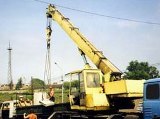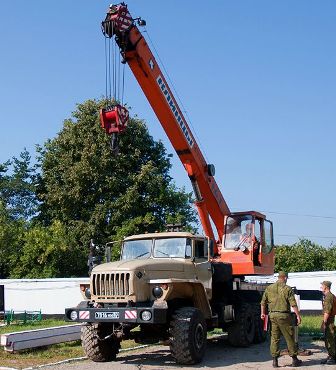What to do if a vehicle cuts a power line wire
 In case of violation of the rules for the passage of large vehicles or transportation of bulky cargo, violation of the rules for carrying out work in the safety zone of power lines or in the case of vehicles passing under a power line that is in an unsatisfactory technical condition, the vehicle means can break the conductor of the power line which is under operating voltage.
In case of violation of the rules for the passage of large vehicles or transportation of bulky cargo, violation of the rules for carrying out work in the safety zone of power lines or in the case of vehicles passing under a power line that is in an unsatisfactory technical condition, the vehicle means can break the conductor of the power line which is under operating voltage.
The entanglement of the wire on the power line leads to disruption of the operation of electrical networks, can cause a fire in a vehicle, and most importantly can lead to electric shock to a person… Therefore, you must know how to behave in case of a given situation. Consider what should be done in the event that a power line conductor is caught by a vehicle.
When the driver discovers that the vehicle is stuck on a power line, the first thing to do is to stop the vehicle.If a vehicle comes into contact with a power line conductor in such a way that with a slight further movement, the conductor stops touching that vehicle, then immediately free the vehicle by moving it. If there is contact with the exposed wire of the movable mechanism of special equipment, then in order to free it from the action of voltage, this mechanism must be removed.
In the event that attempts to free the vehicle from the wire can only worsen the situation, it is necessary to take measures to prevent a possible electric shock to the people in the vehicle.
When a 0.4 kV power line is connected, the vehicle will be under the operating voltage of that power line. In this case, the leakage of current to the ground will be prevented by the rubber tires on the wheels of the vehicle. In this case, people in the vehicle are prohibited from touching the metal elements of the vehicle body.
You should contact the dispatcher of electrical networks, Ministry of Emergency Situations, to take measures to de-energize the damaged power line or part of the electrical installation. It is recommended not to leave the vehicle until it is de-stressed.
If a vehicle has caught the conductor of a high voltage power line, then there is a high probability of a fire on the tires and then on the vehicle itself, because the tires of the vehicle cannot provide insulation of the high voltage from the ground and very quickly start to be degraded by the action of the leakage current to earth.
In the event of a tire fire, leave the vehicle immediately. Evacuate from the vehicle in such a way that you touch the ground with closed feet, the main purpose is to maintain balance so as not to fall under step voltagecaused by the propagation of currents towards the ground.
When evacuating, you must avoid touching your hands and body with the vehicle. After that, you need to move away from the vehicle at a safe distance — more than 8 m, while you need to move only "goose step" (in small steps, without lifting your legs from each other). When moving, you must also maintain balance and not to touch people and foreign objects in the danger zone.
If there are no signs of burning tires, then it is safer to stay in the vehicle until the voltage is removed from the damaged power line.
After notifying representatives of electrical networks about the incident, before the damaged line or section of the electrical installation is turned off, it is necessary to inform people approaching a vehicle that was energized about the possible danger.

Safety measures when working near power lines
In order to avoid catching the transmission line wires from the vehicle, a number of safety measures need to be taken, depending on the specific situation.
When planning work with the use of vehicles, the main safety measure is to de-energize power lines located in the immediate vicinity of the work site.Precautions should also be taken against accidental voltage supply according to power lines, which is ensured by creating a visible gap and grounding power lines on all sides from which voltage supply is possible.
Many incidents occur due to the expansion of the workplace. Therefore, when planning work near power lines, it is necessary to prepare work production projects (PPR), which indicate clear boundaries of the workplace, schemes for the movement of vehicles, their moving elements and various special equipment.
Also, one of the mandatory safety measures is the grounding of vehicles. As a rule, for grounding vehicles, portable protective grounding is used, connected to exposed metal elements of the vehicle body and to specialized places for installing grounding in electrical installations, to metal elements of power line supports that have a direct connection to the ground.
If you need to transport bulky cargo or move large vehicles to places where power lines pass, you must first take a number of security measures.
The first thing to do in this case is to check the proposed vehicle traffic route for the presence of power lines crossing the route. Then you need to contact representatives of the organization operating these power lines to clarify the rules of movement the security zone of each of the power linesintersecting with the proposed route.
Depending on the dimensions of the load or vehicle, the construction of the power line, as well as its voltage class, the necessary safety measures will be determined. If the distance from the load (vehicle) to the wires of the overhead power line is less than permissible, then before the vehicle passes under this overhead line, it must be disconnected and grounded. In some cases where the conductors of the line are located too low, it is necessary to temporarily raise the conductors of the previously disconnected and grounded line.
If the mode of operation of the electrical networks does not allow this power line to be repaired, then in order to ensure the safety of the movement of vehicles, a correction of the route is necessary. In this case, a safer section of the power line is selected, where the distance from the overhead wires to the vehicle (transported load) is acceptable.
